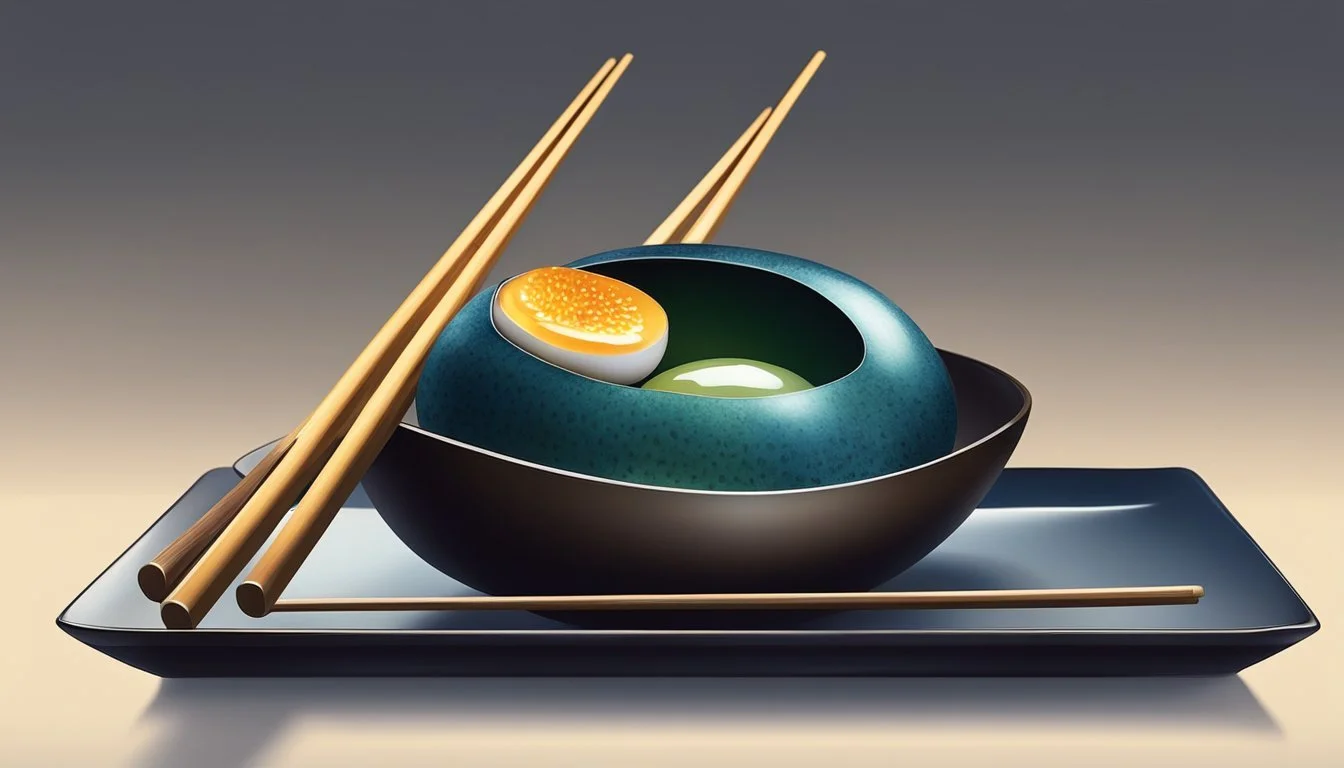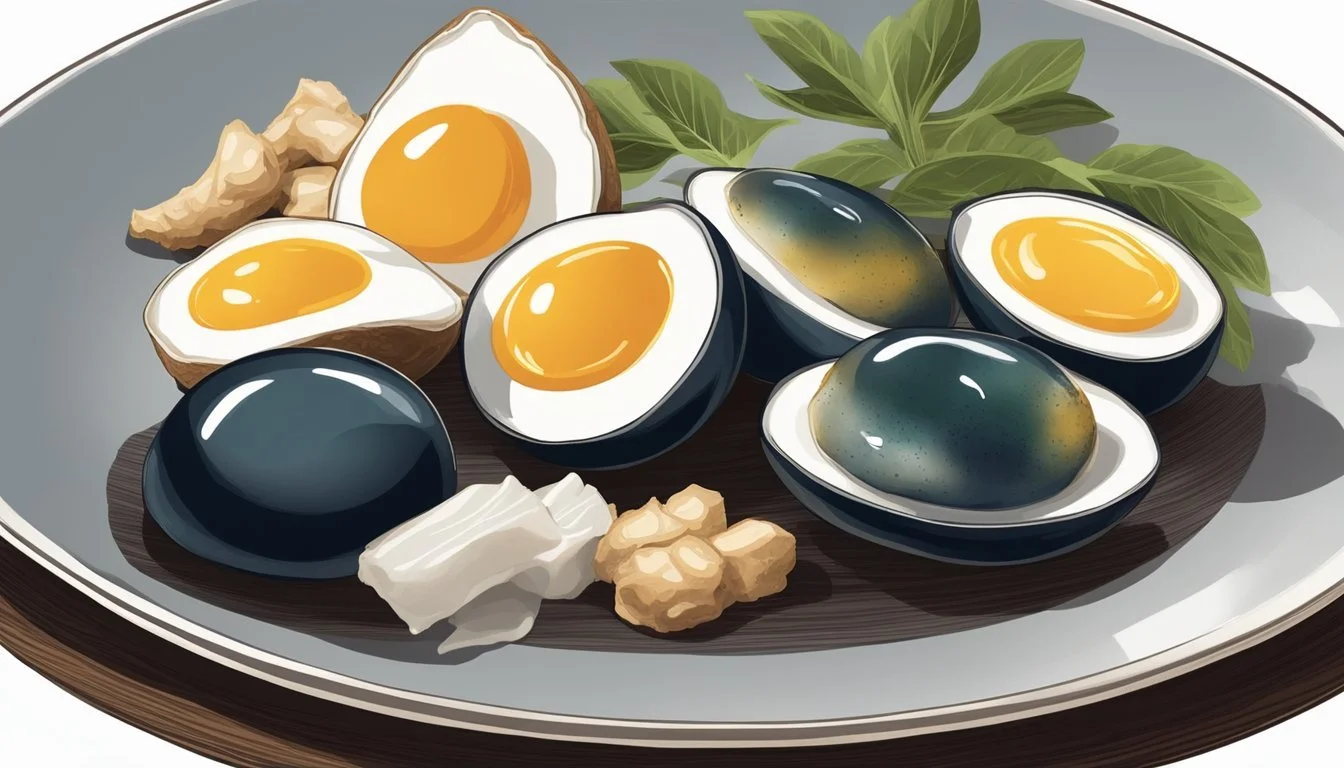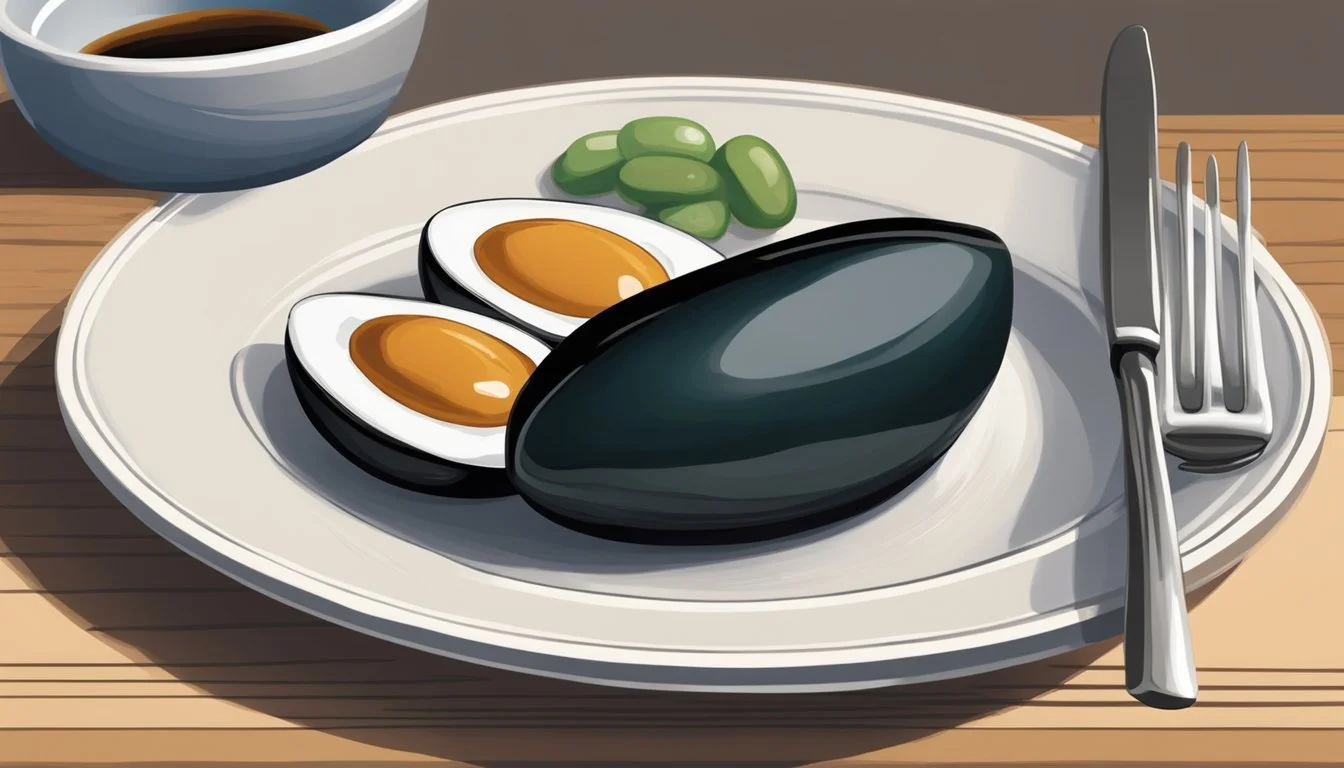How to Eat a Century Egg
A Step-by-Step Guide
Century eggs, also known as preserved eggs or thousand-year eggs, are a unique culinary delicacy traditionally from China. These eggs, typically duck or chicken, undergo a preservation process using an alkaline solution of clay, wood ash, rice husks, quicklime, and salt. The transformation over weeks to months results in a darkened egg with a creamy, pungent yolk and a jelly-like, translucent egg white. The distinctive flavors and aromas of century eggs make them an acquired taste but a celebrated component in various dishes.
Eating a century egg is an experience that embodies the depth of traditional Chinese culinary artistry. The eggs are usually rinsed to remove the surrounding clay or ash before consumption. They can be eaten alone but are often enjoyed in combination with other foods. Sliced and served with pickled ginger, mixed into salads, or used as a topping for congee—Chinese rice porridge—century eggs offer a complex texture and taste that complement the flavors of several Chinese dishes. While their strong flavor is best savored in small bites, century eggs can also be chopped and paired with spring onions before being laid atop tofu or porridge, integrating their bold taste into a more balanced and approachable dish.
What Is a Century Egg?
A century egg, also known as a preserved egg, hundred-year egg, thousand-year egg, or millennium egg, is a traditional Chinese delicacy. Despite its various names, it does not actually preserve for a century; rather, its preservation process lasts for several weeks to months. Century eggs are made by preserving duck eggs, chicken eggs, or less commonly, quail (What wine goes well with quail?) eggs.
The preservation technique transforms the egg into a unique culinary item with a complex flavor profile. The process involves immersing the eggs in a curing mixture of clay, ash, salt, quicklime, and rice hulls. During this period, the egg’s flavors develop and the chemical reactions within alter its texture and taste.
Physical Characteristics:
Color: The treated egg whites become a translucent brown, with a jelly-like consistency.
Yolk: The yolk turns dark green or gray and achieves a creamy, custard-like texture with a strong, savory taste.
Century eggs are typically enjoyed in small quantities due to their potent flavor. Once the curing process is complete, the egg is rinsed clean of the surrounding mixture and then it's ready for consumption. In China, they are commonly sliced and served with pickled ginger, added to porridge or rice, or enjoyed as an appetizer. Their strong umami taste, often accompanied by a subtle smokiness, is considered a delicacy and pairs well with contrasting textures and flavors in various dishes.
Historical Significance
The century egg boasts a storied place in Chinese cuisine, tracing its roots to the Ming Dynasty. Regarded as a prized Chinese delicacy, its origins are steeped in both necessity and ingenuity. The preservation method, born out of the need to store food, served as an early form of food processing in China.
The practice of making century eggs likely began over 600 years ago. During the Ming Dynasty, there was an emphasis on food innovation, which paved the way for the development of unique preservation techniques. The century egg is a testament to these historical culinary advancements. While known under several appellations, such as "preserved egg" or "thousand-year egg," the names often celebrate the transformative nature of the edible art rather than signify the actual age of the egg.
Historically, this food has been more than a mere comestible; it symbolizes a connection to past generations, acting as a tangible link to ancient Chinese food (What wine goes well with Chinese food?) traditions. Serving it is an acknowledgment of one's heritage, making it much more than a cultural delicacy; it is a gastronomic tribute to resilience and creativity.
They are traditionally incorporated into festive occasions and daily meals, thereby embedding them into the cultural fabric of Chinese society. Through the consumption of century eggs, successive generations have a sensorial experience of history, connecting with their ancestors through taste and ceremony.
Ingredients and Preparation
Century eggs, a unique preservation of eggs, combine both tradition and flavor through their intricate curing process. This section focuses on the core components required to create century eggs, the steps involved in their preparation, and addresses safety concerns to ensure a wholesome culinary experience.
Primary Ingredients
The primary ingredients for making century eggs include:
Duck, quail, or chicken eggs: Duck eggs are the most commonly used.
Curing mixture: Typically a combination of clay, ash, salt, quicklime, and rice husk.
Alkaline solution: This can be created using food-grade lye or sodium hydroxide.
The Curing Process
The steps for the curing process are as follows:
Coating: Eggs are coated in a thick layer of the curing mixture.
Curing: The coated eggs are then stored for several weeks to months, during which time the yolk becomes creamy and the whites turn a gelatinous and amber color.
Safety Concerns
When preparing century eggs, safety is paramount:
Toxic chemicals: Use caution to avoid the incorporation of lead oxide or other heavy metals, which can be found in some traditional methods.
Food-grade materials: Ensure that all ingredients, such as food-grade lye or sodium hydroxide, are safe for consumption and do not contain contaminants.
Sensory Profile
Eating a century egg offers a unique sensory experience quite distinct from that of a fresh egg, focusing on its appearance, texture, and taste, while also addressing common misconceptions.
Appearance and Texture
The century egg bears an appearance far removed from a traditional egg. Its yolk typically transforms into a dark green to gray color, often with a creamy consistency, while the egg white becomes a translucent, jelly-like substance with an amber hue. The overall texture can be described as smooth and somewhat succulent, contrasting greatly with a typical hard-boiled egg.
Flavor Profile
The flavor of a century egg is complex and can be an acquired taste. It has notes of ammonia and sulfur, which contribute to its strong aroma, often compared to that of certain strong cheeses. Its taste is rich and reminiscent of umami, with a slight sharpness that can be enhanced with condiments like Sichuan pepper. This intensity in flavor is what defines the century egg and distinguishes it from other preserved foods.
Common Misconceptions
One major misconception is that century eggs are toxic or contain high levels of bacteria, hence their pungent smell. However, the preservation process effectively prevents the growth of bacteria, rendering the eggs safe to consume. The odor, while strong, is not indicative of the egg being rotten; rather, it's a byproduct of the chemical reactions during its curing process. Contrary to what some might think due to the name, these eggs are not preserved for hundreds of years; the term "century" is a figurative description of the egg's prolonged preservation time compared to fresh eggs.
Cultural Variations
Century eggs, also known as preserved eggs, pidan, or thousand-year-old eggs, are a distinctive Asian dish. They hold various names and are integrated into local cuisines in unique ways.
Regional Names and Variants
Preserved eggs go by various names across different regions. In particular:
China: Referred to commonly as pidan, which can be translated to "pine-patterned egg" due to the patterns that form on the white during preservation.
Hunan: In this province, they may be labeled more descriptively as thousand-year-old eggs.
Vietnam: They carry the name hot vit lon, an indication of their cultural integration.
Hong Kong: Known as century eggs, they're a favorite local delicacy.
Serving Practices in Different Regions
Different regions have developed unique ways of consuming century eggs:
China: They are often eaten with congee (rice porridge), offering a creamy texture and rich flavor to the simple dish. Cold tofu topped with sliced century eggs and condiments such as soy sauce and katsuobushi is a popular way to serve them in Taiwan.
Vietnam: Here, they might be enjoyed as a side dish or within salads.
Hong Kong: Century eggs can be found sliced and served on their own or as part of an appetizer platter.
These serving practices reflect the regional preferences and culinary traditions that embrace the intriguing flavors and textures of century eggs.
Serving Suggestions
When incorporating century eggs into meals, one can explore a variety of traditional methods as well as more contemporary culinary innovations. The subtleties of its unique flavor are best appreciated when paired or prepared properly.
Traditional Pairings
Century eggs are often savored in traditional Chinese cuisine. They may be thinly sliced and served with pickled ginger root, which provides a sharp contrast to the egg’s rich taste. A classic way to enjoy century eggs is within a warm bowl of congee or rice porridge, where they are combined with additional ingredients such as lean pork, white fish (What wine goes well with white fish?), or tofu, and garnished with sesame oil and soy sauce for extra flavor. This combination not only harmonizes flavors but also adds textural variety to the dish.
Congee or Rice Porridge: A comforting base that complements the egg's texture.
Toppings can include: Tofu, crispy fried dough, fish.
Garnishing: Sesame oil, soy sauce, and spring onions.
Modern Takes on Serving Century Egg
Chefs and culinary enthusiasts often give a modern twist to serving century eggs, crafting dishes that appeal to a broader audience while respecting the ingredient's heritage. One might find century eggs featured in an omelette enriched with vegetables like spinach and herbs, bringing a fresh perspective to this delicacy. Century egg salads, often tossed with a light black vinegar dressing, are becoming a popular alternative, offering a nuanced flavor profile that can serve as an appetizer or a side dish.
Century Egg Omelette: Infused with herbs and fresh vegetables.
Tofu Salad with Century Egg: A fusion dish drizzled with sesame dressing.
Guidelines for Consumption
For those new to century eggs, it is important to note that they are an acquired taste. Start by trying small quantities, perhaps as an ingredient within a larger dish, to become accustomed to its distinct flavor and aroma. When consuming, begin with modest bites to appreciate the complexity of its taste. Always ensure that the eggs are sourced from reputable suppliers, guaranteeing safety and quality in the preparation and consumption of this Chinese delicacy.
Initial Tasting: Small portions are recommended; consider pairing with other flavors.
Safety: Only purchase from trusted sellers to ensure authenticity and food safety.
Nutritional Information
Century eggs are a unique food item, known for their distinct flavor and rich nutritional profile. They are a source of several important nutrients and have a higher protein content compared to regular eggs. Protein is essential for muscle repair, immune function, and overall health.
Protein Content: Compared to regular eggs, century eggs contain a higher percentage of proteins. These proteins are abundant in amino acids, which are the building blocks of proteins and are crucial for bodily functions.
Iron and Minerals: Century eggs are a good source of iron, an important mineral for blood production and the transport of oxygen throughout the body. Additionally, they contain selenium, which plays a key role in maintaining a healthy immune system and regulating thyroid function.
Cholesterol Levels: Like regular eggs, century eggs have cholesterol. Consumers should be mindful of their overall dietary cholesterol intake. However, it's important to consider the entire diet rather than focusing on individual foods.
Nutrient Composition:
Nutrient Amount Protein Higher than regular eggs Iron Good source Selenium Present Cholesterol Contains
Century eggs can be part of a balanced diet. They offer a variety of nutrients that contribute to a person's nutritional needs. Individuals with specific dietary requirements or health concerns should consult healthcare professionals to ensure these eggs are appropriate for their diet.
How to Make Century Eggs at Home
Making century eggs at home requires patience and adherence to safety guidelines. By using food-grade ingredients and following a precise recipe, home chefs can prepare these preserved eggs without using toxic chemicals.
Required Ingredients and Materials
Ingredients:
1.5 liters of water
72 grams of food-grade sodium chloride (salt)
42 grams of food-grade sodium hydroxide (lye) or lime
Fresh eggs
Materials:
Large plastic container
Weighing scale
Cooking pot
Wooden spoon
Protective gloves and eyewear
Step-by-Step Guide
Preparation of Curing Solution:
Dissolve 72 grams of salt and 42 grams of sodium hydroxide or lime in 1.5 liters of water.
Stir the mixture over low heat until fully dissolved, then bring to a boil.
Allow the solution to cool completely before using it.
Curing the Eggs:
Place the eggs carefully into the plastic container.
Pour the cooled curing solution over the eggs, ensuring they are fully submerged.
Seal the container and store it in a cool, dark place for several weeks to months.
Rinsing:
Once the curing process is complete, remove the eggs from the solution.
Rinse the eggs under running water to remove any residue from the curing solution.
Coating (optional):
Some recipes may suggest coating the eggs in a mixture of rice husk and wood ash for an authentic finish.
Safety Tips
Always use food-grade sodium hydroxide or lime to avoid the introduction of toxic chemicals.
Wear protective gloves and eyewear when handling the curing solution to protect against skin and eye irritation.
Ensure proper ventilation in the area where you're mixing the curing solution.
Never use metal containers or utensils as they can react with the sodium hydroxide. Use plastic or glass materials instead.
By following these careful steps and safety measures, one can create century eggs that are safe to consume and share the rich flavors that this traditional delicacy has to offer.
Health and Safety
When consuming century eggs, it's crucial to consider both their unique nutrient content and the food safety practices necessary to ensure they are enjoyed safely and responsibly.
Potential Health Benefits
Century eggs are known for their high protein content, making them a nutritious food choice. Additionally, they are believed to contain health benefits such as aiding in lowering blood pressure. It is the preservation process that not only gives the eggs their distinctive flavor but may also enhance certain nutrient values.
Possible Health Risks
Despite the nutritional value, there are potential health risks associated with century eggs. Toxic chemicals such as lead oxide have been used in some traditional preservation methods, which can lead to heavy metal contamination. Consumers should ensure that they purchase century eggs from reputable sources to avoid the ingestion of toxic chemicals.
Handling and Storage
Correct handling and storage are paramount for maintaining the food safety and extending the shelf life of century eggs. After peeling, century eggs should be:
Stored at room temperature: safe for up to 2 weeks.
Refrigerated: safe for consumption for up to a month.
Refrigeration is especially important if the eggs are not consumed immediately after peeling. The eggs must be kept in a cool, dry place, away from direct sunlight and varying temperatures to preserve their quality and safety.
Frequently Asked Questions
In addressing common queries about century eggs, one should understand their safety, flavor profile, and the myths surrounding their age.
Can Century Eggs Be Toxic?
Toxicity: Century eggs are typically safe to consume when prepared correctly. There have been concerns about the use of lead oxide in the curing process, which is toxic and can pose a risk to food safety. However, this practice is largely outdated and illegal in many countries. Consumers should ensure they purchase century eggs from reputable sources to avoid potential contaminants.
What Does Century Egg Taste Like?
Flavor Profile: The taste of a century egg is complex, often described as a blend of ammonia and sulfur, and it's an acquired taste for many. Despite these potent flavors, it’s a delicacy appreciated for its unique taste. The flavor can be balanced with other foods, such as tofu or congee, and is typically enjoyed in small bites to savor its richness.
Are Century Eggs Actually Century Old?
Misconception and History: Despite the name, century eggs are not a product of a hundred years. This is a common misconception. They are preserved for several weeks to months using a traditional curing process that involves clay, ash, and quicklime. The history of their name is more linked to the preservation technique rather than the actual age of the eggs.








